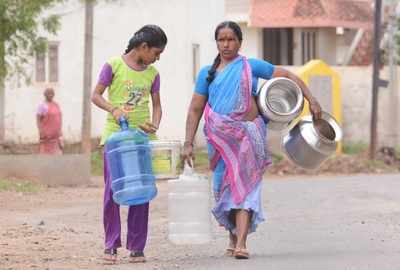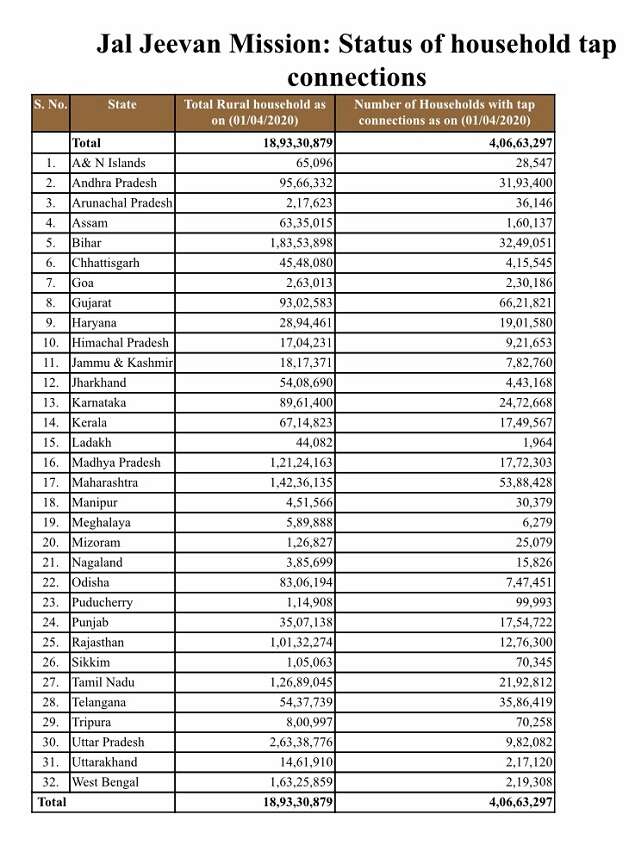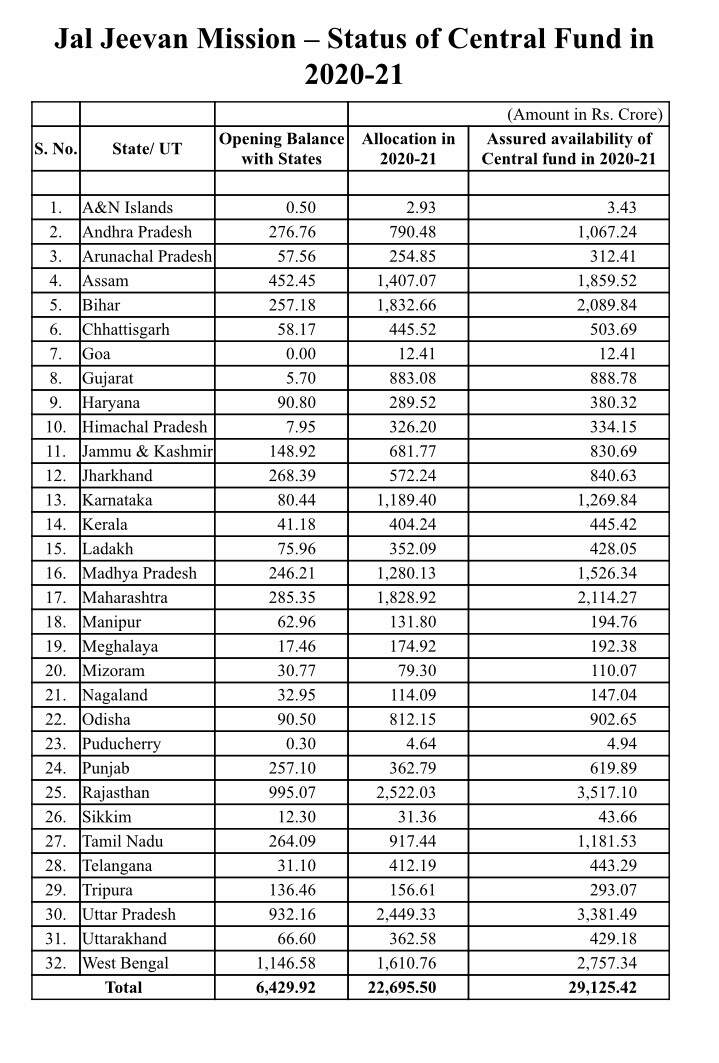Top Searches
- News
- India News
- Centre finds gaps in implementation of rural drinking water plan in Maharashtra, West Bengal and Odisha, asks CMs to step up their efforts
Centre finds gaps in implementation of rural drinking water plan in Maharashtra, West Bengal and Odisha, asks CMs to step up their efforts

NEW DELHI: As part of its attempt to sensitise states towards implementing its flagship scheme of providing tap connections for drinking water to all rural households in the country by 2024, the Centre has asked Maharashtra, West Bengal and Odisha to step up their efforts in a campaign mode to achieve the goal of ‘Har Ghar Jal’.
Maharashtra, West Bengal and Odisha are among those 10 states which have submitted their plan to achieve the target of 100% rural households with tap connections by 2024, unlike other big states such as Bihar and Uttar Pradesh which have committed to do so much ahead of the national goal. These three - Maharashtra, Odisha and West Bengal - are also among the states which could not reach their respective targets of 2019-20.
Asking for speedy implementation of the scheme, Union Jal Shakti (water resources) minister Gajendra Singh Shekhawat in his letter to Maharashtra chief minister Uddhav Thackeray urged to involve local village community and user groups to achieve drinking water security in the state where 62% of its 1.42 crore rural households still don’t have functional tap connections.
Shekhawat requested the state for “retrofitting and augmentation of existing 8,268 piped water supply schemes” so that as many as 22.35 lakh households can get tap connection during the current financial year.
The Centre has approved nearly Rs 1,829 crore for Maharashtra for implementation of the scheme - Jal Jeevan Mission (JJM) - in 2020-21. The state had in 2019-20 provided tap connections to only 5.45 lakh households as against its target of 16.26 lakh tap connections.
West Bengal had turn out to be among worst performing states in last financial year. Against the target of providing tap connections to 32 lakh households in the year 2019-20, only 4,750 tap connections were provided in the state.
In his letter to West Bengal government, Shekhawat has underlined the slow progress of the scheme in the state and mentioned how it could spend only Rs 428 crore out of Rs 994 crore allocated to it under the scheme during 2019-20.
The minister also flagged that a total of around Rs 1305 crore has been released to West Bengal for providing potable water to Arsenic/Fluoride- affected habitations since March, 2017, but Rs 573 crore is still lying unutilised with the state.
West Bengal has total 1.63 crore rural households, but the state has, so far, not covered even 2% of it with tap connections.
Odisha too has reported slow progress.
In 2019-20, against the target of 15.61 lakh, only 4.37 lakh (27.97%) households were provided with tap connections in the State.
This lag resulted in the low utilization of fund. Odisha was allocated around Rs 364 crore in 2019-20, out of which the State could utilise only Rs 275 crore.
Since the State was unable to utilize the funds fully, Shekhawat has requested Odisha government to review the planning and implementation strategy for water supply schemes, so as to expedite physical progress and improve fund utilisation.
Launched in August last year, the JJM aims to ensure potable water supply in adequate quantity (55 litres per person per day) and of prescribed quality to every rural household on regular and long-term basis across the country.
The Centre has allocated Rs 3.60 lakh Crore for this Mission where the central share is Rs 2.08 Lakh Crore with remaining Rs 1.52 Crore to be borne by States till 2024.
The Jal Shakti ministry has, so far, this year allocated over Rs 29,000 crore to states under the JJM and asked them to speed up works to meet their respective targets. States have also been asked to enrol migrant labourers, who returned to their states due to Covid-19 situation, for works under the Mission and utilise
existing resources through convergence of various programmes like MGNREGS, JJM, District Mineral Development Fund, CAMPA, CSR Fund and Local Area Development Fund at village level. The states have been asked to prepare Village Action Plan (VAP) for every village by dovetailing all these resources.
Timeline for states to achieve 100% Functional Household Tap Connections (FHTCs) as per their self-declared targets
100% FHTCs in 2021: Bihar, Goa, Puducherry, Telangana
100% FHTCs in 2022: Haryana, Jammu & Kashmir, Ladakh, Himachal Pradesh, Gujarat, Meghalaya, Punjab, Uttar Pradesh, Sikkim
100% FHTCs in 2023: Arunachal Pradesh, Karnataka, Madhya Pradesh, Manipur, Mizoram, Nagaland, Tripura, Chhattisgarh
100% FHTCs in 2024:Assam, Andhra Pradesh, Jharkhand, Kerala, Maharashtra, Odisha, Rajasthan, Tamil Nadu, Uttarakhand, West Bengal


Maharashtra, West Bengal and Odisha are among those 10 states which have submitted their plan to achieve the target of 100% rural households with tap connections by 2024, unlike other big states such as Bihar and Uttar Pradesh which have committed to do so much ahead of the national goal. These three - Maharashtra, Odisha and West Bengal - are also among the states which could not reach their respective targets of 2019-20.
Asking for speedy implementation of the scheme, Union Jal Shakti (water resources) minister Gajendra Singh Shekhawat in his letter to Maharashtra chief minister Uddhav Thackeray urged to involve local village community and user groups to achieve drinking water security in the state where 62% of its 1.42 crore rural households still don’t have functional tap connections.
Shekhawat requested the state for “retrofitting and augmentation of existing 8,268 piped water supply schemes” so that as many as 22.35 lakh households can get tap connection during the current financial year.
The Centre has approved nearly Rs 1,829 crore for Maharashtra for implementation of the scheme - Jal Jeevan Mission (JJM) - in 2020-21. The state had in 2019-20 provided tap connections to only 5.45 lakh households as against its target of 16.26 lakh tap connections.
West Bengal had turn out to be among worst performing states in last financial year. Against the target of providing tap connections to 32 lakh households in the year 2019-20, only 4,750 tap connections were provided in the state.
In his letter to West Bengal government, Shekhawat has underlined the slow progress of the scheme in the state and mentioned how it could spend only Rs 428 crore out of Rs 994 crore allocated to it under the scheme during 2019-20.
The minister also flagged that a total of around Rs 1305 crore has been released to West Bengal for providing potable water to Arsenic/Fluoride- affected habitations since March, 2017, but Rs 573 crore is still lying unutilised with the state.
West Bengal has total 1.63 crore rural households, but the state has, so far, not covered even 2% of it with tap connections.
Odisha too has reported slow progress.
In 2019-20, against the target of 15.61 lakh, only 4.37 lakh (27.97%) households were provided with tap connections in the State.
This lag resulted in the low utilization of fund. Odisha was allocated around Rs 364 crore in 2019-20, out of which the State could utilise only Rs 275 crore.
Since the State was unable to utilize the funds fully, Shekhawat has requested Odisha government to review the planning and implementation strategy for water supply schemes, so as to expedite physical progress and improve fund utilisation.
Launched in August last year, the JJM aims to ensure potable water supply in adequate quantity (55 litres per person per day) and of prescribed quality to every rural household on regular and long-term basis across the country.
The Centre has allocated Rs 3.60 lakh Crore for this Mission where the central share is Rs 2.08 Lakh Crore with remaining Rs 1.52 Crore to be borne by States till 2024.
The Jal Shakti ministry has, so far, this year allocated over Rs 29,000 crore to states under the JJM and asked them to speed up works to meet their respective targets. States have also been asked to enrol migrant labourers, who returned to their states due to Covid-19 situation, for works under the Mission and utilise
existing resources through convergence of various programmes like MGNREGS, JJM, District Mineral Development Fund, CAMPA, CSR Fund and Local Area Development Fund at village level. The states have been asked to prepare Village Action Plan (VAP) for every village by dovetailing all these resources.
Timeline for states to achieve 100% Functional Household Tap Connections (FHTCs) as per their self-declared targets
100% FHTCs in 2021: Bihar, Goa, Puducherry, Telangana
100% FHTCs in 2022: Haryana, Jammu & Kashmir, Ladakh, Himachal Pradesh, Gujarat, Meghalaya, Punjab, Uttar Pradesh, Sikkim
100% FHTCs in 2023: Arunachal Pradesh, Karnataka, Madhya Pradesh, Manipur, Mizoram, Nagaland, Tripura, Chhattisgarh
100% FHTCs in 2024:Assam, Andhra Pradesh, Jharkhand, Kerala, Maharashtra, Odisha, Rajasthan, Tamil Nadu, Uttarakhand, West Bengal


FacebookTwitterLinkedinMail
Start a Conversation
end of article
Trending Topics
Quick Links
Coronavirus in MumbaiCoronavirus in KolkataCoronavirus in HyderabadCoronavirus in DelhiCoronavirus in BangaloreCoronavirus symptomsCoronavirus in IndiaWhat is CoronavirusCoronavirus NewsSolar EclipseNPRWhat is NRCCAB BillCAB and NRCRTI BillPodcast newsLok SabhaShiv SenaYSRCPCongressBJP newsUIDAIIndian ArmyISRO newsSupreme Court